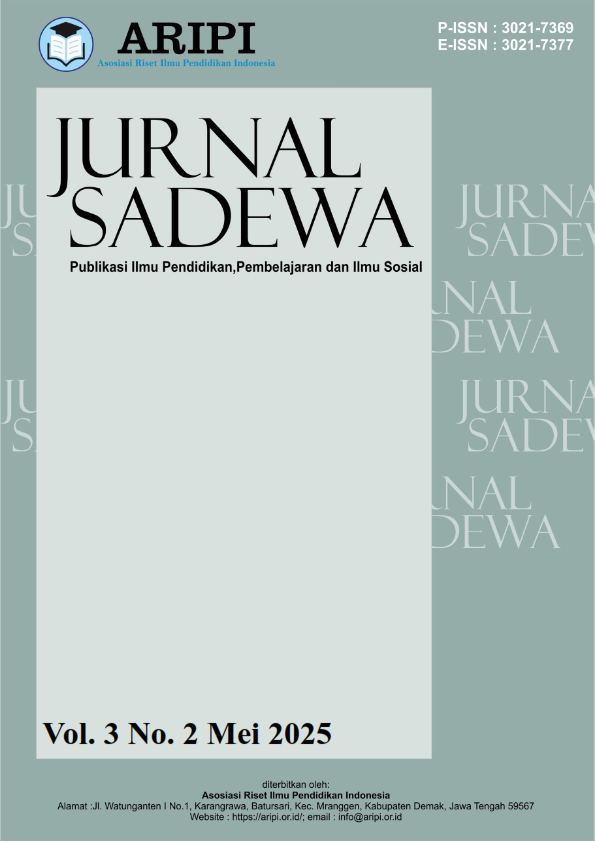The Passage of Time: Unraveling Memory in Clear Light of Day
DOI:
https://doi.org/10.61132/sadewa.v3i2.1649Keywords:
Nostalgia, Achievement Motivation, Alienation, Reconciliation, FragmentationAbstract
This qualitative research delves into Anita Desai’s Clear Light of Day, focusing on the themes of time and memory and their profound impact on personal and familial identities. Set against the historical backdrop of Old Delhi and the partition of India, the novel explores how time both destroys and preserves, while memory serves as a key element in shaping characters’ psychological experiences and relationships. Through a close textual analysis, the study investigates how Desai intertwines these themes to highlight emotional struggles, alienation, and eventual reconciliation. Drawing on the philosophical insights of T.S. Eliot, who portrays time as both a “Destroyer and Preserver,” the research explores how these forces influence character development and the evolution of family dynamics. The findings underscore the significance of time and memory in the process of emotional healing and self-reconciliation, providing a deeper understanding of the novel’s psychological and thematic complexities.
Downloads
References
Aethi, Sunil. “Interview with Anita Desai.” The Indian Review of Books, vol. 5, no. 4, 1981, p. 142.
Biswas, P. C., and M. J. Talukder. “Exploring Indian Women’s Psyche in Anita Desai’s Clear Light of Day: A Psychoanalysis.” International Journal of Research and Innovation in Social Sciences, vol. 8, no. 1, 2024, pp. 549-554.
Desai, Anita. Clear Light of Day. Penguin Random House India, 2007.
---. “Tremendous Changes, Interview” by Sunil Sethi. India Today, 1-5 Dec. 1980, p. 142.
Gunduz, Ela Ipek. “Clear Light of Day: Fragmented Postcolonial Lives.” Inonu University International Journal of Social Sciences (INIJOSS), vol. 6, no. 1, 2017, pp. 175-180.
Hashmi, A. “A Reading of Anita Desai’s Clear Light of Day.” International Fiction Review, vol. 10, no. 1, 1983, pp. 56-58.
Heidari, Marjan, Mina Abbasiyannejad, and Ashkan Shobeiri. “Women’s Struggle for Identity in Anita Desai’s Clear Light of Day.” The International Journal of the Humanities, vol. 9, no. 3, 2011, pp. 31-39. DOI: 10.18848/1447-9508/CGP/v09i03/43152.
Hedges, Elaine S. The Fiction of Anita Desai: Imagining the Family. University of California Press, 1995.
Mallik, Srabani. “Bondage of Time and Human Bondage in Anita Desai’s Clear Light of Day.” International Journal of English Literature and Social Sciences (IJELS), vol. 5, no. 4, 2020, pp. 1036-1041. DOI: 10.22161/ijels.54.32.
McDonald, Robert. “Time, Memory, and Identity in Anita Desai’s Novels.” South Asian Review, vol. 24, no. 1, 2003, pp. 33-47.
Rao, R. Raj. “Anita Desai: A Study of the Alienated Self.” Indian Literature, vol. 31, no. 3, 1988, pp. 122-134.
Sannrud, Kirsti Weel. “Themes, Symbolism, and Imagery in Anita Desai’s Clear Light of Day.” MA thesis, Dept. of Literature, Area Studies, and European Languages, Faculty of Humanities, University of Oslo, 2008.
Sharma, Kajali. Symbolism in Anita Desai’s Novel. Shakthi Malik Abhinav Publications, 1991.
S, Daniel Gnanaraj. “Time as a Destroyer and Preserver in Anita Desai’s Clear Light of Day.” Literary Endeavour, vol. X, no. 2, 2019, pp. 272-279.
Talukder, M. J., and P. C. Biswas. “Clear Light of Day: Exploring Social Dynamics through Illuminating Relationships.” Praxis International Journal of Social Sciences and Literature, vol. 6, no. 11, 2023, pp. 13-21.
Tomar, Ruchi. “Postmodern Female Psyche with Reference to Anita Desai’s Clear Light of Day.” The Criterion: An International Journal in English, vol. IV, no. V, 2013, pp. 1-4.
Tyagi, Dr. Bharati. “Clear Light of Day: From Alienation to Affirmation.” International Research Journal of Commerce Arts and Science (CASIR), vol. 3, no. 3, 2012, pp. 867-871.
Yadrami, Shasidhar, and Dr. Vibha Gupta. “Memory in Desai’s Fiction: A Study in the Light of Paul Ricoeur’s Perspective on Time and Narrative.” International Journal of Innovative Research on Science, Engineering and Technology (IJRSET), vol. 10, Special Issue 2, 2020, pp. 168-172.
Downloads
Published
How to Cite
Issue
Section
License
Copyright (c) 2025 Jurnal Sadewa : Publikasi Ilmu Pendidikan, pembelajaran dan Ilmu Sosial

This work is licensed under a Creative Commons Attribution-ShareAlike 4.0 International License.






